Nissan Pathfinder: Starting and driving - Intelligent Blind Spot Intervention (I-BSI)
Basic information Nissan Pathfinder 2022
WARNING Failure to follow the warnings and instructions for proper use of the I-BSI system could result in serious injury or death.
- The I-BSI system is not a replacement for proper driving procedure and is not designed to prevent contact with vehicles or objects. When changing lanes, always use the side and rear mirrors and turn and look in the direction you will move to ensure it is safe to change lanes. Never rely solely on the I-BSI system.
- There is a limitation to the detection
capability of the radar or the sonar.
Not every moving object or vehicle will be detected. Using the I-BSI system under some road, ground, lane marker, traffic or weather conditions could lead to improper system operation.
Always rely on your own operation to avoid accidents.
The I-BSI system helps alert the driver of other vehicles in adjacent lanes when changing lanes, and helps assist the driver to return the vehicle to the center of the traveling lane.
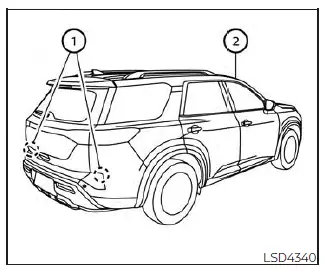
The I-BSI system uses radar sensors 1 installed near the rear bumper to detect other vehicles in an adjacent lane. In addition to the radar sensors, the I-BSI system uses a camera 2 installed behind the windshield to monitor the lane markers of your traveling lane.
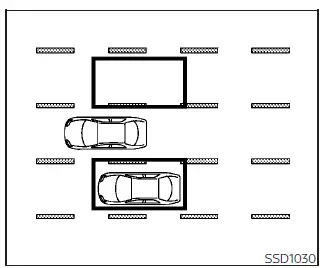
Detection zone
The radar sensors can detect vehicles on either side of your vehicle within the detection zone shown as illustrated.
The detection zone starts from the outside mirror of your vehicle and extends approximately 10ft (3.0m) behind the rear bumper, and approximately 10ft (3.0 m) sideways.
I-BSI system operation Nissan Pathfinder 2022
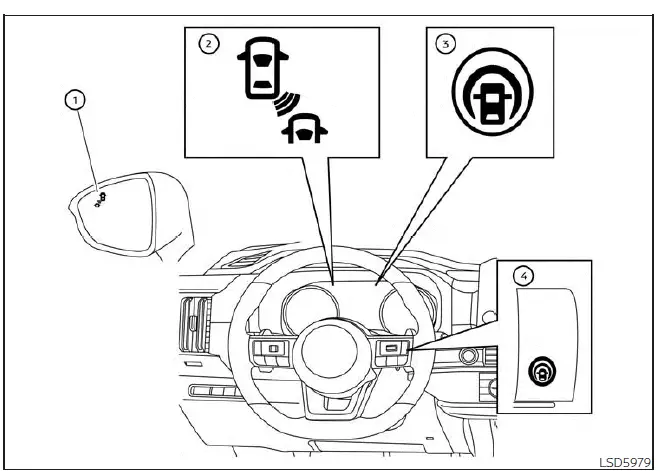
For vehicles with the 7 inch (18 cm) display
- Side indicator light
- BSW indicator
- Intelligent Blind Spot Intervention (I-BSI) indicator
- ProPILOT Assist switch
The I-BSI system operates above approximately 37 mph (60 km/h).
If the radar sensors detect a vehicle in the detection zone, the side indicator light (1) illuminates.
If the turn signal is then activated, the system chimes (twice) and the side indicator light and the BSW indicator light 2 flash.
The side indicator light continues to flash until the detected vehicle leaves the detection zone. The brightness of the side indicator light is adjusted automatically depending on the brightness of the ambient light.
If the I-BSI system is ON and your vehicle approaches a lane marker while another vehicle is in the detection zone, the system chimes (three times) and the side indicator light and the BSW indicator light 2 flash.
The I-BSI system activates by controlling the braking input of the vehicle for a short period of time to help return the vehicle back to the center of the driving lane. The I-BSI system operates regardless of turn signal usage.
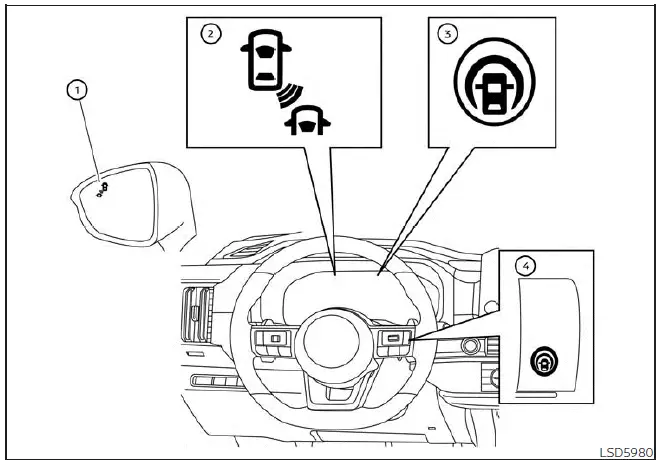
For vehicles with the 12.3 inch (31.2 cm) display
NOTE:
- I-BSI warning and system application
will only be activated if the side indicator
light is already illuminated when
your vehicle approaches a lane marker.
If another vehicle comes into the detection zone after your vehicle has crossed a lane marker, no I-BSI warning or system application will be activated.
- The I-BSI system is typically activated prior to the Intelligent Lane Intervention (I-LI) system when your vehicle is approaching a lane marker.
To turn on the I-BSI system, push the ProPILOT Assist switch on the steering wheel after starting the engine. The I-BSI indicator will illuminate. Push the ProPILOT Assist switch again to turn off the I-BSI system.
The I-BSI indicator will turn off.
How to enable/disable the I-BSI system
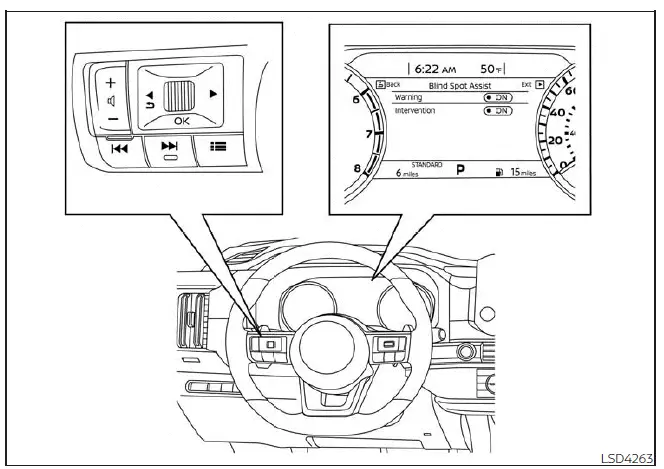
For vehicles with the 7 inch (18 cm) display
Perform the following steps to enable or disable the I-BSI system:
1. Press the
 button until
"Settings" displays
in the vehicle information display.
button until
"Settings" displays
in the vehicle information display.
Use the scroll dial to select "Driver Assistance." Then press the OK button.
2. Select "Blind Spot Assist" and press the OK button.
3. Select "Intervention" and use the OK button to turn the system on or off.
4. Push the ProPILOT Assist switch to turn the system on or off.
NOTE:
- Turning on the ProPILOT Assist system will turn on the I-BSI and I-LI system at the same time. For additional information, see "Intelligent Lane Intervention (I-LI)". Turning the I-BSI system on will activate the BSW system at the same time.
- When enabling/disabling the system, the system will retain current settings even if the engine is restarted.
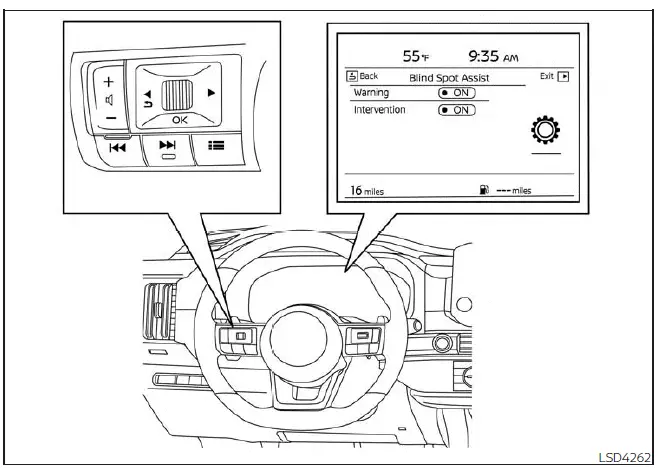
For vehicles with the 12.3 inch (31.2 cm) display
I-BSI system limitations Nissan Pathfinder 5th Gen
WARNING Listed below are the system limitations for the I-BSI system. Failure to operate the vehicle in accordance with these system limitations could result in serious injury or death.
- The I-BSI system cannot detect all vehicles under all conditions.
- The radar sensors may not be able to
detect and activate I-BSI when certain
objects are present such as:
- Pedestrians, bicycles, or animals.
- Vehicles such as motorcycles, low height vehicles, or high ground clearance vehicles.
- Vehicles remaining in the detection zone when you accelerate from a stop.
- Oncoming vehicles.
- A vehicle merging into an adjacent lane at a speed approximately the same as your vehicle.
- A vehicle approaching rapidly from behind.
- A vehicle which your vehicle overtakes rapidly.
- A vehicle that passes through the detection zone quickly.
- The radar sensors' detection zone is designed based on a standard lane width. When driving in a wider lane, the radar sensors may not detect vehicles in an adjacent lane. When driving in a narrow lane, the radar sensors may detect vehicles driving two lanes away.
- The radar sensors are designed to ignore most stationary objects; however, objects such as guardrails, walls, foliage and parked vehicles may occasionally be detected. This is a normal operation condition.
- The following conditions may reduce
the ability of the radar to detect other
vehicles:
- Severe weather
- Road spray
- Ice/frost/dirt build-up on the vehicle
- Do not attach stickers (including transparent material), install accessories or apply additional paint near the radar sensors. These conditions may reduce the ability of the radar to detect other vehicles.
- The camera may not detect lane
markers in the following situations
and the I-BSI system may not operate
properly.
- On roads where there are multiple parallel lane markers; lane markers that are faded or not painted clearly; yellow painted lane markers; non-standard lane markers; lane markers covered with water, dirt, snow, etc.
- On roads where discontinued lane markers are still detectable.
- On roads where there are sharp curves.
- On roads where there are sharply contrasting objects, such as shadows, snow, water, wheel ruts, seams or lines remaining after road repairs.
- On roads where the traveling lane merges or separates.
- When the vehicle's traveling direction does not align with the lane markers.
- When traveling close to the vehicle in front of you, which obstructs the lane camera unit detection range.
- When rain, snow or dirt adheres to the windshield in front of a lane camera unit.
- When the headlights are not bright due to dirt on the lens or if aiming is not adjusted properly.
- When strong light enters a lane camera unit. (For example: light directly shines on the front of the vehicle at sunrise or sunset.)
- When a sudden change in brightness occurs. (For example: when the vehicle enters or exits a tunnel or under a bridge.) When the vehicle's traveling direction does not align with the lane markers.
- When traveling close to the vehicle in front of you, which obstructs the lane camera unit detection range.
- When rain, snow or dirt adheres to the windshield in front of a lane camera unit.
- When the headlights are not bright due to dirt on the lens or if aiming is not adjusted properly.
- When strong light enters a lane camera unit. (For example: light directly shines on the front of the vehicle at sunrise or sunset.)
- When a sudden change in brightness occurs. (For example: when the vehicle enters or exits a tunnel or under a bridge.)
- Do not use the I-BSI system under the
following conditions because the
system may not function properly.
- During bad weather (for example: rain, fog, snow, etc.).
- When driving on slippery roads, such as on ice or snow, etc.
- When driving on winding or uneven roads.
- When there is a lane closure due to road repairs.
- When driving in a makeshift or temporary lane.
- When driving on roads where the lane width is too narrow.
- When driving with a tire that is not within normal tire conditions (e.g., tire wear, low tire pressure, installation of spare tire, tire chains, non-standard wheels).
- When the vehicle is equipped with non-original brake parts or suspension parts.
- When towing a trailer or other vehicle.
- Excessive noise (e.g., audio system volume, open vehicle window) will interfere with the chime sound, and it may not be heard.
I-BSI driving situations
Basic information
Indicator on

Indicator off

Indicator flashing

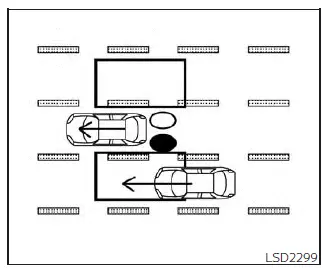
Illustration 1 - Approaching from behind
Another vehicle approaching from behind
Illustration 1: The side indicator light illuminates if a vehicle enters the detection zone from behind in an adjacent lane.
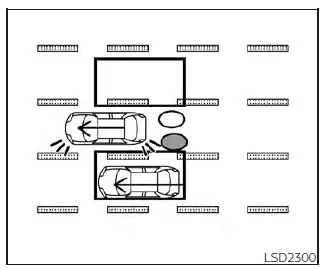
Illustration 2 - Approaching from
behind
Illustration 2: If the driver activates the turn signal then the system chimes a sound (twice) and the side indicator light and the BSW indicator flash.
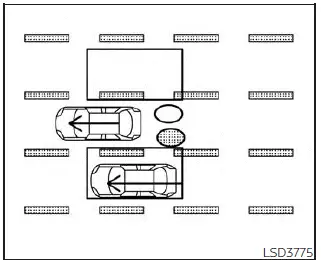
Illustration 3 - Approaching from
behind
Illustration 3: If the I-BSI system is on and your vehicle approaches a lane marker while another vehicle is in the detection zone, the system chimes (three times) and the side indicator light and the BSW indicator flash. Then the I-BSI system activates to help return the vehicle back to the center of the driving lane.
NOTE:
- The radar sensors may not detect vehicles which are approaching rapidly from behind.
- If the driver activates the turn signal before a vehicle enters the detection zone, the side indicator light and the BSW indicator will flash but no chime will sound when the other vehicle is detected.
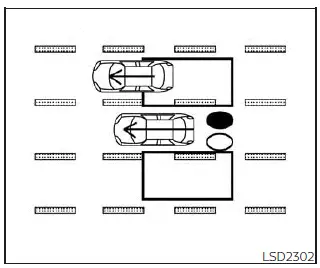
Illustration 4- Overtaking another
vehicle
Overtaking another vehicle
Illustration 4: The side indicator light illuminates if you overtake a vehicle and that vehicle stays in the detection zone for approximately 3 seconds.
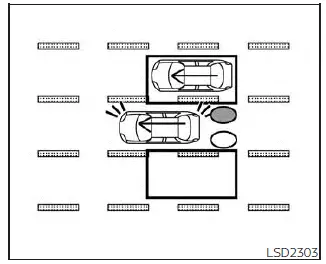
Illustration 5- Overtaking another
vehicle
Illustration 5: If the driver activates the turn signal while another vehicle is in the detection zone, then the system chimes (twice) and the side indicator light and the BSW indicator flash.
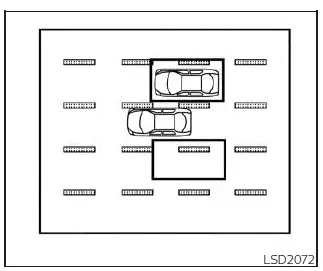
Illustration 6- Overtaking another
vehicle
Illustration 6: If the I-BSI system is on and your vehicle approaches a lane marker while another vehicle is in the detection zone, the system chimes (three times) and the side indicator light and the BSW indicator flash. The I-BSI system activates to help return the vehicle back to the center of the driving lane.
NOTE:
- When overtaking several vehicles in a row, the vehicles after the first vehicle may not be detected if they are traveling close together.
- The radar sensors may not detect slower moving vehicles if they are passed quickly.
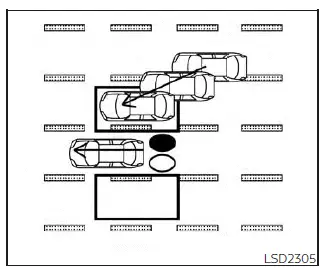
Illustration 7- Entering from the side
Entering from the side
Illustration 7: The side indicator light illuminates if a vehicle enters the detection zone from either side.
NOTE: The radar sensors may not detect a vehicle which is traveling at about the same speed as your vehicle when it enters the detection zone.

Illustration 8- Entering from the side
Illustration 8: If the driver activates the turn signal while another vehicle is in the detection zone, then the side indicator light and the BSW indicator flash and a chime will sound twice.
NOTE: If the driver activates the turn signal before a vehicle enters the detection zone, the side indicator light will flash but no chime will sound when another vehicle is detected.
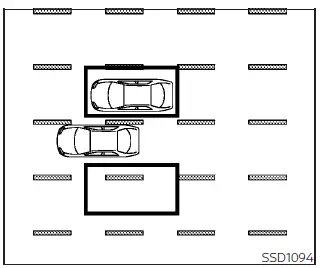
Illustration 9- Entering from the side
Illustration 9: If the I-BSI system is on and your vehicle approaches the lane marker while another vehicle is in the detection zone, the system chimes (three times) and the side indicator light and the BSW indicator flash. The I-BSI system activates to help return the vehicle back to the center of the driving lane.
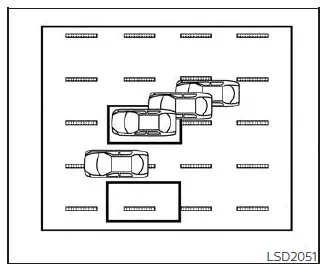
Illustration 10: - Entering from the side
Illustration 10: The I-BSI system will not operate if your vehicle is on a lane marker when another vehicle enters the detection zone. In this case only the BSW system operates.
NOTE:
- The radar sensors may not detect a vehicle which is traveling at about the same speed as your vehicle when it enters the detection zone.
- I-BSI will not operate or will stop operating
and only a warning chime will
sound under the following conditions:
- When the brake pedal is depressed.
- When the vehicle is accelerated during I-BSI system operation.
- When steering quickly.
- When the ICC, I-FCW or AEB with Pedestrian Detection warnings sound.
- When the hazard warning flashers are operated.
- When driving on a curve at a high speed.
- When the BSW system is turned off.
System temporarily unavailable Nissan Pathfinder Fifth generation
Under the following conditions, a chime will sound, the following message will appear in the vehicle information display and the I-BSI system will be turned off automatically.
The I-BSI system will not be available until the conditions no longer exist.
- "Not available Poor Road Conditions"
- When the VDC system (except TCS function) or ABS operates.
- "Currently not available"
- When the VDC system is turned off.
- When the SNOW mode, or the MUD/ RUT mode or SAND mode (4WD models only) is selected
- "Unavailable High Cabin Temperature": If the vehicle is parked in direct sunlight under high temperature conditions (over approximately 104ºF (40ºC) ).
- "Unavailable Side Radar Obstruction": When side radar blockage is detected.
Turn off the I-BSI system and turn it on again when the above conditions no longer exist.
System malfunction
When the I-BSI system malfunctions, it will be turned off automatically, a chime will sound, and the "Not available System Malfunction" warning message with the BSW indicator (orange) will appear in the vehicle information display.
Action to take:
Stop the vehicle in a safe location, place the vehicle in the P (Park) position, turn the engine off and restart the engine. If the "Not available System Malfunction" warning message with the BSW indicator (orange) continues to be displayed, have the I-BSI system checked. It is recommended you visit a certified NISSAN dealer for this service.
System maintenance
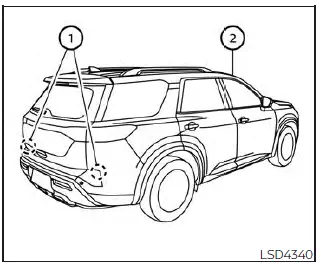
Basic information
The two radar sensors 1 for the I-BSI system are located near the rear bumper. Always keep the area near the radar sensors clean.
The radar sensors may be blocked by temporary ambient conditions such as splashing water, mist or fog.
The blocked condition may also be caused by objects such as ice, frost or dirt obstructing the radar sensors.
Check for and remove objects obstructing the radar sensors.
Do not attach stickers (including transparent material), install accessories or apply additional paint near the radar sensors.
Do not strike or damage the area around the radar sensors.
It is recommended you visit a certified NISSAN dealer if the area around the radar sensors is damaged due to a collision.
The lane camera unit 2 for I-BSI system is located above the inside mirror. To keep the proper operation of I-BSI and prevent a system malfunction, be sure to observe the following:
- Always keep the windshield clean.
- Do not attach a sticker (including transparent material) or install an accessory near the camera unit.
- Do not place reflective materials, such as white paper or a mirror, on the instrument panel. The reflection of sunlight may adversely affect the camera unit's capability of detecting the lane markers.
- Do not strike or damage the areas around the camera unit. Do not touch the camera lens or remove the screw located on the camera unit. It is recommended that you contact a certified NISSAN dealer if the camera unit is damaged due to an accident.
Radio frequency statement
For USA
CAUTION TO USERS
Changes or modifications not expressly approved by the party responsible for compliance could void the user's authority to operate the equipment.
This device complies with Part 15 of the FCC Rules and with the RSS of the Industry Canada. Operation is subject to the following two conditions:
1. This device may not cause harmful interference, and 2. this device must accept any interference received, including interference that may cause undesired operation.
In order to comply with FCC RF Exposure requirements, this device must be installed to provide at least 20 cm separation from the human body at all times.
For Canada
This device complies with Industry Canada licence-exempt RSS standard(s).
Operation is subject to the following two conditions: (1) this device may not cause interference, and (2) this device must accept any interference, including interference that may cause undesired operation of the device.
Afin de se conformer aux exigences d'exposition RF MIC / FCC / ISED, cet appareil doit etre installe pour foutnir au moins 20 cm de separation du corps humain en tout temps.

Nissan Pathfinder (R53) 2022-2025 Owner's Manual
Intelligent Blind Spot Intervention (I-BSI)
Contact Us
Nissan Pathfinder Info Center
Email: info@nipathfinder.com
Phone: +1 (800) 123-4567
Address: 123 Pathfinder Blvd, Nashville, TN 37214, USA
Working Hours: Mon–Fri, 9:00 AM – 5:00 PM (EST)
